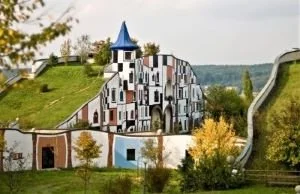Friedensreich Hundertwasser
Luxury Retail Client: Print Materials, Website
As the 20th century progressed, education was made available to all and people became more mobile, artists developed their own styles, free of the need to associate their work with ‘movements’. They were able, for practical purposes, to work under the term ‘contemporary’. They were able to pick and choose their styles, gather inspiration from everywhere and create work that was completely unique. Friedensreich Hundertwasser was one such artist; by the end of the century, he was one of Austria’s most famous contemporary artists.
Friedensreich Hundertwasser was born in Vienna on December 15th, 1928 as Friedrich Stowasser. After high school, he entered the Vienna School of Arts but soon left, feeling that travel would be more worthwhile. After visiting France, Morocco, Tunisia, Spain and Italy, he returned with a new name: Friedensreich Regentag Dunkelbunt Hundertwasser. The direct English translation of this is ‘Peace-Realm Rainy Day Darkly-Coloured Hundred-Water’. Thereafter, he was known simply as ‘Hundertwasser’ (and “the Austrian Gaudi”).
Hundertwasser's first commercial success was a 1952 exhibition of his paintings in Vienna. That was followed by equally successful exhibitions in Tokyo, Stockholm, New York, Chicago and Bern. The common themes in his work were bright colours, organic forms and no straight lines, which he called "the devil's tools". Along the way, he was a painter, architect, designer, educator and environmental activist.
Hotel Rogner, Bad Blumau
There was no doubt that he was a great eccentric. He was big on manifestos, and of delivering them in the nude. In his 1958 Mouldiness Manifesto, he came out in favour of mould, saying that it’s a good thing when walls start to get mouldy, “when moss grows in a corner of a room, rounding its geometric angles…because, together with the microbes and fungi, life is moving into the house.” In 1977, he came out against traditional toilets, wanting everyone to the Humus Toilet (this was prescient; composting toilets are, in many places, becoming a thing).
In the 1950s, Hundertwasser turned to architecture. He began designing buildings with features such as undulating floors, and trees growing through rooms. He had grown up with the Bauhaus angular cleanliness, all carefully measured and efficiently segmented. He was utterly opposed to this, and developed new shapes, such as the spiral house and the eye-slit house, and became an advocate for environmentally-friendly buildings.
Hommage a Hundertwasser
In 1973, Hundertwasser traveled to New Zealand and saw a place where he could realize his dream of living and working with nature. He bought a farm and got busy, planting 100,000 indigenous trees, creating canals, ponds and water purification plants, and using solar and water energy. He submitted proposals for stamps, a new flag, and several buildings—all were rejected, but he became a New Zealand citizen in 1983. One proposal, however, did come to fruition—the Kawakawa Public Toilet, which draws busloads of tourists and is the most photographed toilet in New Zealand (and, presumably, the world).
Hundertwasser refused to fly and always traveled via sail boat or cruise ship. On a trip to Europe on board the Queen Elizabeth II in February 2000, he passed away at sea, at age 71. Friedensreich Regentag Dunkelbunt Hundertwasser is buried in harmony with nature on his land in New Zealand, under a tulip tree, in the Garden of the Happy Dead.

